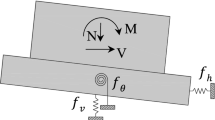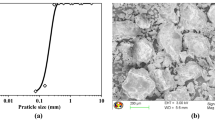Abstract
Direct determination of seismic wave velocities in the laboratory is becoming common practice worldwide, given its great potential in the definition of the stiffness at very small strains. One of the techniques for seismic wave measurement makes use of piezoelectric transducers, such as bender elements (BE). However, some limitations remain to the applicability of this technique, namely for stiff geomaterials, such as compacted soils, naturally or artificially cemented soils and soft or weak rocks. To overcome this issue, two accelerometers have been used in conjunction with BE. In the present paper, this combined test setup implemented on a stress-path triaxial chamber will be detailed. An application study will be presented for a hard soil, prepared by laboratory compaction and tested in triaxial compression at different isotropic stress levels. The equipments, procedures and interpretation analyses will also be described. The advantages of this setup are twofold: (1) the interpretation of the acceleration measurements is straightforward, since the signals are of the same nature; (2) these measurements can be used to verify the BE signals, and thus minimize the subjectivity of the interpretation of BE results. Additionally, the accelerometers can be used autonomously wherever the interpretation of BE becomes too complex. The results of this research enabled to validate the interpretation methods used for BE testing. Moreover, this combined setup of transducers provided a simple yet powerful tool for eliminating the subjectivity inherent to BE testing, enabling reliable measurements of small-strain stiffness for a wide range of materials.



Similar content being viewed by others
References
Anagnostopoulos A et al (eds) (2011) Proceedings of the 15th European conference on soil mechanics and geotechnical engineering. IOS Press, Amsterdam
Arroyo M, Greening P, Muir Wood D (2001) An estimate of uncertainty in current pulse test practice. Riv Ital Geotec 37(1):17–35
Clayton CRI, Theron M, Best AI (2004) The measurement of vertical shear-wave velocity using side-mounted bender elements in the triaxial apparatus. Géotechnique 54(7):495–498
Dyvik R, Madshus C (1985) Lab measurements of Gmax using bender elements. Proceedings ASCE annual convention: advances in the art of testing soils under cyclic conditions, Detroit, Michigan, pp 186–197
Ferreira C (2009) The use of seismic wave velocities in the measurement of stiffness of a residual soil. PhD thesis in Civil Engineering. Universidade do Porto
Gomes Correia A, Viana da Fonseca A, Gambin M (2004) Routine and advanced analysis of mechanical in situ tests. In: Viana da Fonseca A, Mayne PW (eds) Geotechnical and geophysical site characterization, Keynote Lecture, vol 1. Millpress, Rotterdam, pp 75–95
Greening PD, Nash DFT (2004) Frequency domain determination of G0 using bender elements. ASTM Geotech Test J 27(3):1–7
Greening PD, Nash DFT, Benahmed N, Viana da Fonseca A, Ferreira C (2003) Comparison of shear wave velocity measurements in different materials using time and frequency domain techniques. Proceedings of deformation characteristics of geomaterials, Lyon, France, September 2003. Balkema, pp 381–386
GDS Instruments (2009) Bender elements datasheet. http://www.gdsinstruments.com/products/gdsbes.htm. Last accessed at Feb 2011
Jovičić V, Coop MR, Simic M (1996) Objective criteria for determining Gmax from bender element tests. Géotechnique 46(2):357–362
Martins JP (2011) Compaction and its influence on the structural behaviour of high speed railways. PhD thesis in Civil Engineering. University of Minho
Rio J (2006) Advances in laboratory geophysics using bender elements. PhD thesis in Civil Engineering. University College London, University of London
Viana da Fonseca A, Ferreira C, Fahey M (2009) A framework for interpreting bender element tests, combining time-domain and frequency-domain methods. Geotech Test J ASTM 32(2):1–17
Viggiani G, Atkinson JH (1995) Interpretation of bender element tests. Géotechnique 45(2):149–154
Acknowledgments
This work was developed under the research activities of C-TAC from University of Minho, with the financial support provided by FCT (Portuguese Foundation for Science and Technology) in the form of the research project WaveSoil—PTDC/ECM/122751/2010 and the strategic project PEst-OE/ECI/UI4047/2011. The second author acknowledges the support of FCT in the form of the PhD scholarship SFRH/BD/32571/2006.
Author information
Authors and Affiliations
Corresponding author
Additional information
*Previously published in Anagnostopoulos et al. (2011). Reprinted—Published in revised form with kind permission of IOS Press.
Rights and permissions
About this article
Cite this article
Ferreira, C., Martins, J.P. & Gomes Correia, A. Determination of the Small-Strain Stiffness of Hard Soils by Means of Bender Elements and Accelerometers. Geotech Geol Eng 32, 1369–1375 (2014). https://doi.org/10.1007/s10706-013-9678-7
Received:
Accepted:
Published:
Issue Date:
DOI: https://doi.org/10.1007/s10706-013-9678-7




